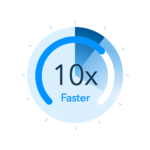Images are often one of the largest assets on a website, and if not optimized properly, they can slow down your web application’s performance significantly. As a React developer, it’s essential to understand how to handle images efficiently to improve web performance and ensure a smooth user experience. In this guide, we’ll explore various strategies and best practices for optimizing image loading in React applications.
How to Improve Web Performance with Loading Images in React
1. Lazy Loading of the Images
It is the technique where images loaded only when they come into the viewport, instead of loading all images upfront. This reduces the initial page load time and improves performance.
How to Implement Lazy Loading in React
1. Using React LazyLoad Library:
Install the library:
npm install react-lazyload
Usage:
import React from 'react';
import LazyLoad from 'react-lazyload';
const ImageComponent = () => (
<LazyLoad height={200} offset={100}>
<img src="/path/to/image.jpg" alt="example" />
</LazyLoad>
);
export default ImageComponent;
This ensures that the image is loaded only when it is about to appear in the viewport.
Also read: React JS Interview Questions for Senior Developer
2. Using Intersection Observer API:
You can also manually implement lazy loading using the browser’s Intersection Observer API:
import React, { useState, useEffect } from 'react';
const LazyImage = ({ src, alt }) => {
const [isVisible, setIsVisible] = useState(false);
const imgRef = React.useRef(null);
useEffect(() => {
const observer = new IntersectionObserver(
([entry]) => {
if (entry.isIntersecting) {
setIsVisible(true);
observer.disconnect();
}
},
{ threshold: 0.1 }
);
if (imgRef.current) {
observer.observe(imgRef.current);
}
return () => {
if (observer && imgRef.current) {
observer.unobserve(imgRef.current);
}
};
}, []);
return (
<img
ref={imgRef}
src={isVisible ? src : ''}
alt={alt}
style={{ minHeight: '200px', minWidth: '200px', background: '#eee' }}
/>
);
};
export default LazyImage;
2. Optimize Image Formats
Choosing the right image format can significantly impact the loading time of your images. Latest formats like **WebP** and **AVIF** can compress the data in a good way and keeps the quality as compared to old fotmats like JPEG and PNG.
How to Use Modern Image Formats
– Use an image optimization service like Cloudinary, ImageKit, or Imgix to serve WebP/AVIF images.
– Use the `<picture>` element for fallback support:
<picture> <source srcSet="/path/to/image.webp" type="image/webp" /> <img src="/path/to/image.jpg" alt="example" /> </picture>
– Tools like Sharp or Squoosh can also convert images to WebP locally during the build process.
Bonus post: Optimizing Node.js Performance: Strategies for Experienced Developers
3. Implement Responsive Images
Responsive images ensure that the browser loads the appropriate image size based on the device’s screen resolution and viewport size. This minimizes unnecessary data transfer.
Using the `srcSet` Attribute
The `srcSet` attribute allows you to specify multiple image sources for different resolutions:
<img src="/path/to/image-480w.jpg" srcSet="/path/to/image-480w.jpg 480w, /path/to/image-800w.jpg 800w" sizes="(max-width: 600px) 480px, 800px" alt="example" />
In this example, the browser will choose the best image based on the user’s screen size and resolution.
4. Use Content Delivery Networks (CDNs)
Serving images through a CDN reduces latency and ensures faster delivery by caching assets closer to the user’s location.
Popular CDNs for Images
– Cloudinary: Offers image optimization, resizing, and CDN services.
– ImageKit: Provides real-time image transformation and CDN delivery.
– AWS CloudFront: Integrates with Amazon S3 for image hosting and delivery.
How to Use a CDN in React
Simply upload your images to the CDN service and replace the image URLs in your code with the CDN-provided URLs.
5. Compress Images
Compressed images reduce file sizes while maintaining acceptable visual quality, leading to faster loading times.
Tools for Image Compression
– TinyPNG: Online tool for compressing PNG and JPEG files.
– ImageOptim: Desktop app for macOS.
– Sharp: Node.js library for server-side image compression.
Automating Image Compression
Use build tools like Webpack or Vite to compress images during the build process. For example:
npm install image-webpack-loader --save-dev
Add the loader to your Webpack config:
{
test: /\.(png|jpe?g|gif)$/i,
use: [
{
loader: 'file-loader',
},
{
loader: 'image-webpack-loader',
options: {
mozjpeg: {
progressive: true,
},
optipng: {
enabled: true,
},
pngquant: {
quality: [0.65, 0.9],
},
},
},
],
}
6. Use Skeleton Screens or Placeholders
Displaying a placeholder while the image is loading improves the perceived performance and enhances user experience.
How to Add Placeholders in React
– Use libraries like React LazyLoad or react-placeholder:
import React from 'react'; import ContentLoader from 'react-content-loader'; const ImagePlaceholder = () => ( <ContentLoader> <rect x="0" y="0" width="100%" height="200" /> </ContentLoader> ); export default ImagePlaceholder;
– Add a CSS-based placeholder:
const LazyImage = ({ src, alt }) => {
const [loaded, setLoaded] = React.useState(false);
return (
<div style={{ background: loaded ? 'none' : '#f0f0f0', minHeight: '200px' }}>
<img
src={src}
alt={alt}
onLoad={() => setLoaded(true)}
style={{ display: loaded ? 'block' : 'none' }}
/>
</div>
);
};
7. Cache Control
Ensure that images are cached in the user’s browser to avoid unnecessary reloads. This can be configured in your CDN or server settings by setting appropriate cache headers:
– Cache-Control: Set `max-age` for long-term caching.
– ETag: Use to validate if cached assets are still fresh.
8. Use Image Sprites (Where Applicable)
For icons or small images, combine them into a single sprite sheet to reduce HTTP requests.
How to Use Sprites in React
– Create a sprite sheet using tools like SpritePad or CSS Sprite Generator.
– Use CSS to display specific parts of the sprite:
.icon {
background: url('/path/to/sprite.png') no-repeat;
}
.icon-home {
background-position: 0 0;
}
.icon-user {
background-position: -50px 0;
}
Conclusion
Optimizing image loading in React is a critical step towards improving web performance. By implementing techniques like lazy loading, responsive images, modern formats, and caching, you can create faster and more efficient web applications. Prioritize performance optimization during development to deliver a seamless user experience and reduce the risk of user drop-off due to slow loading times.


